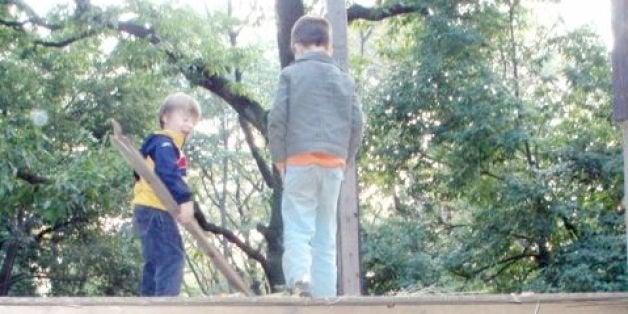
With adventure playgrounds and the benefits of children's risk-taking coming into our cultural consciousness, we're learning more than ever the advantages of a hands-off parenting approach. Helicopter parenting has gotten such a bad rap; you would think the time would be ripe to embrace this. Yet, the hands-off approach I experienced at an adventure playground in Tokyo is actually more demanding, in some respects, than helicopter vigilance.
I am the mother of three, but I was alone at the adventure playground in Tokyo, having jumped at the chance to live and work briefly with a playworker there. Adventure playgrounds, first designed in 1943, are un-built outdoor play spaces -- frequently dirt lots -- filled with donated materials and sometimes, tools. They are places where children are encouraged to take risks -- to sometimes play with fire, literally -- and where an adult playworker is there to facilitate children's play, but not to direct it. As you might imagine, these playgrounds are few and far between in the U.S.: our best known, year-round adventure playground is the 34-year-old Adventure Playground at Berkeley Marina in Berkeley, CA.
I was walking around with Noriko, the playworker who was my hostess. This particular morning, a young teenage girl -- I'll call her Kiko -- wandered into the playground in her iconic navy blue uniform. She was cutting school; that much we knew.
I watched as Noriko did not do the following: comment on her truancy; ask whether she was depressed, on drugs, or a runaway. Instead, Noriko set the three of us up to play catch. We used a wooden toy an older gentleman had made by hand in the playground that morning.
This bamboo toy, a taketumbo, looked a lot like what I used to call a helicopter when I was a kid. It had the shape of that pale brown maple seed, but with a longer stem. This is how you make a taketumbo fly: you place the stem between your palms, rub one hand against the other, then release it. The gist of our game was this: hold the taketumbo; say, because it was fun to say and connected us, "ba-ching"; laugh; release taketumbo towards someone else; laugh again.
After an hour or so of this, Kiko left. I saw her again the next day, at the playground, in her school uniform. She had brought her boyfriend, who was clad in black leather. Both young people said hello politely. We did not play catch. She looked happy.
That was the extent of my interaction with her. I wondered about her mother; she would likely never know that her daughter had spent part of her day playing catch with another mother from literally a world away. I felt empathy for this parent I would never meet. I was not yet a mother of a teen, but I could imagine it: her kid had gone off to school that morning, by all accounts dressed and ready. Then what?
Ba-ching. We deride helicopter parenting, but maybe the problem is that we are thinking of the wrong person in the wrong helicopter. It's the children, not the parents, who are meant to fly; we know that. But it's hard to acknowledge this fact about our children: As parents, we are the ones who hold them, yes, and we are also the ones who release them -- towards who? What? Well, you don't always get to know that.
At the playground, I learned a lot about not intervening. My work in this area continues at home, although not, of course, as dramatically. In NYC, my kids are not -- alas! -- experimenting with open fires or leaping from the playpark hut roof onto a pile of old mattresses. Not intervening looks a lot more micro here. My kids go to school, have homework and do some organized activities. I try to let them schedule their own time as much as possible. I try to let them play freely and take risks. It is sad to see how difficult this is.
But letting kids take risks is only part of it. As we struggle to find our way out of helicoptering, we need a correction that is more beneficial than a mere pendulum swing to hands-off land. The challenge adventure playgrounds present to us is that they ask for a hands-off approach that is not an absence. It's a different kind of presence, one that ultimately requires more from us: more trust, more generosity, more of a recognition of all that we get in return when we recognize that our children are ours, yes; they are also children of and in the wider space of the world, a space that has many unknowns in it. Adventure playgrounds ask: can we stop resisting that? Can we embrace it?